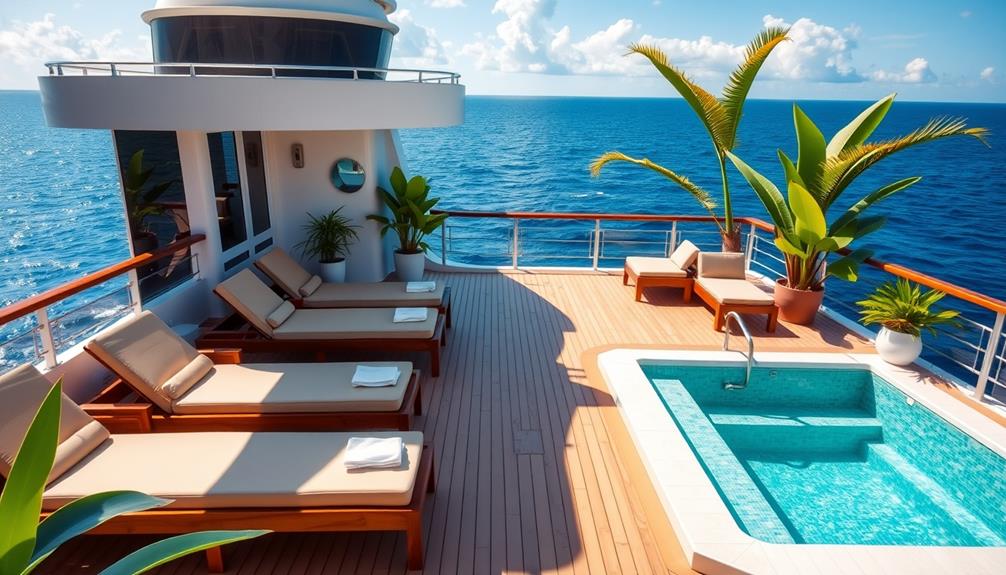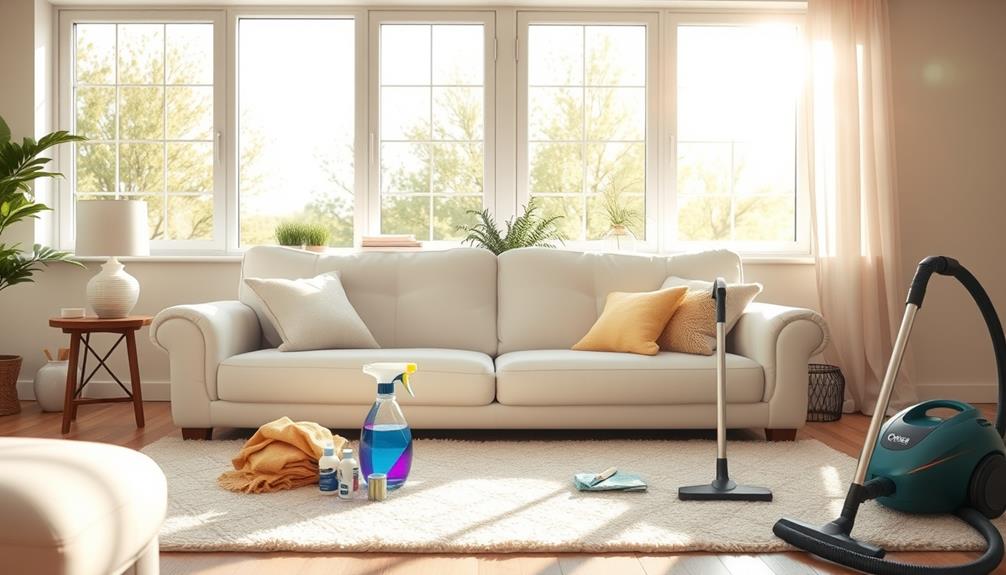Navigating topless sunbathing on your cruise can be simple once you understand the guidelines. Start by reviewing the policies of your cruise line—Virgin Voyages allows it, while Norwegian Cruise Line does not. To maintain privacy, you may want to consider booking a cabin with a balcony or utilizing designated sun decks and spa areas. Destinations like St. Martin and St. Barts are known for embracing this practice, enhancing the overall experience. Remember to apply high-SPF sunscreen and stay hydrated to protect yourself. It’s also important to be mindful of cultural norms when visiting ports. By taking these factors into consideration, you can fully enjoy topless sunbathing, with plenty more to discover on how to make the most of it. To elevate your topless sunbathing experience, think about investing in a comfortable and stylish swimsuit or cover-up that can be easily removed while on the ship or at appropriate locations. Additionally, delving into the history and cultural significance of topless sunbathing around the world can lead to a deeper appreciation of the practice. As you continue to explore the world of topless sunbathing, consider how you can transform your home or backyard into a tranquil retreat where you can enjoy this experience in a more private setting. As you embrace the joys of topless sunbathing, you might also explore transformative concepts for women’s retreats, which can focus on self-care, body positivity, and empowerment. These retreats often create safe spaces for women to connect, relax, and celebrate their bodies in a supportive environment. By integrating elements of topless sunbathing into such retreats, participants can foster a sense of freedom and confidence, encouraging each other to appreciate their own unique beauty.
Key Takeaways
- Research your cruise line's policies on topless sunbathing, as rules vary significantly between companies.
- Choose private sunbathing options like balcony cabins or adult-only areas for more comfort and privacy.
- Plan to visit destinations known for welcoming topless sunbathing, such as St. Martin and St. Barts.
- Pack essentials like high SPF sunscreen, a beach towel, and a light cover-up for comfort and protection.
- Be respectful of local customs and fellow passengers' boundaries to ensure a positive experience for everyone.
Understanding Cruise Line Policies

Maneuvering the landscape of cruise line policies can be a bit tricky, especially when it comes to topless sunbathing. Each cruise line has its own rules, so it's essential to know what's allowed before you set sail.
For instance, Virgin Voyages permits topless sunbathing, making it a popular choice for those looking to soak up the sun without a top. In contrast, Norwegian Cruise Line strictly prohibits it, while Royal Caribbean and Celebrity Cruises have restrictions that apply only on select itineraries.
Be sure to research your cruise line's policies and respect the cultural norms of the destinations you're visiting. This way, you'll guarantee a comfortable experience for you and your fellow passengers while enjoying your time in the sun.
Private Sunbathing Options

For those who prefer a more secluded sunbathing experience while cruising, booking a balcony cabin can be the perfect solution. You'll enjoy the privacy and stunning ocean views right from your own space. Additionally, some cruise lines offer designated sun decks where you can relax without the crowds.
Here's a quick comparison of private sunbathing options:
| Option | Description |
|---|---|
| Balcony Cabin | Private space with ocean views |
| Designated Sun Decks | Areas for topless sunbathing |
| Spa Decks | Relaxation areas with fewer people |
| Adult-Only Areas | Exclusive zones for adult sunbathing |
| Private Cabanas | Rent a cabana for ultimate privacy |
Destinations for Topless Sunbathing

When it comes to finding the perfect destinations for topless sunbathing, the Caribbean and parts of Europe stand out as top choices.
These locations not only embrace a relaxed atmosphere but also have stunning beaches that invite you to soak up the sun.
Here are three must-visit spots:
- St. Martin – Known for its beautiful beaches, you'll find plenty of places where topless sunbathing is welcomed.
- St. Barts – This upscale island offers gorgeous beaches and a laid-back vibe perfect for sunbathing without the top.
- Guadeloupe – With its warm climate and beautiful shores, this destination is great for enjoying the sun in a carefree manner.
Pack your sunscreen and get ready for a sun-soaked adventure!
Tips for a Comfortable Experience

Finding the right spot for topless sunbathing is just the beginning; guaranteeing a comfortable experience is key to enjoying your time in the sun.
First, apply a high SPF sunscreen generously, focusing on sensitive areas. Reapply every few hours and after swimming.
Bring a comfortable beach towel or mat to lay on, as this can enhance your relaxation. Stay hydrated by drinking plenty of water, especially in the heat.
Consider wearing a wide-brimmed hat and sunglasses for added sun protection. If you're prone to getting cold, pack a light cover-up for when the sun dips or if a breeze kicks up.
Cultural Considerations and Respect

Understanding cultural considerations and showing respect are vital when you decide to sunbathe topless during your cruise.
Different regions have varying attitudes toward topless sunbathing, so it's important to be aware of these differences to guarantee a positive experience for yourself and others.
Here are three key points to keep in mind:
- Research Policies: Check your cruise line's rules regarding topless sunbathing, as they can vary greatly.
- Observe Local Norms: Familiarize yourself with the customs of the ports you'll visit, as some places may embrace topless sunbathing while others may not.
- Be Mindful of Others: Consider the comfort of fellow passengers and respect their boundaries to maintain a harmonious atmosphere on board.
Frequently Asked Questions
Can I Sunbathe Topless in the Pool Area?
Whether you can sunbathe topless in the pool area depends on the cruise line's policies. Always check specific rules for your cruise, as some lines permit it while others strictly prohibit topless sunbathing.
Are There Any Age Restrictions for Topless Sunbathing?
When you're basking in the sun, age restrictions can vary. Typically, cruise lines allow adults, but policies differ. Always check specific guidelines to guarantee your sun-soaked experience remains carefree and enjoyable for everyone involved.
What Should I Wear if Topless Sunbathing Is Not Allowed?
If topless sunbathing isn't allowed, opt for a comfortable bikini or swimsuit. Consider lightweight cover-ups for added sun protection. Always respect the cruise line's dress code and enjoy your time by the pool!
Can I Bring My Own Sunbathing Towel or Mat?
Absolutely, you can bring your own sunbathing towel or mat! Just check your cruise line's specific policies to guarantee compliance. It'll enhance your comfort while enjoying the sun and the ocean breeze.
Are There Any Designated Time Slots for Topless Sunbathing?
You might think designated time slots exist for topless sunbathing, but they typically don't. Instead, check specific cruise policies and enjoy sunbathing when it feels right, respecting others' comfort and preferences while soaking up the sun.
Conclusion
As you set sail on your sun-soaked adventure, keep in mind that embracing a little freedom under the sun can be a delightful experience. By knowing the rules and respecting the comfort of those around you, you can enjoy your time to the fullest. Whether you find a private nook or enjoy the open air, let your worries drift away and soak up the warmth—after all, it's all about finding your perfect slice of paradise.









